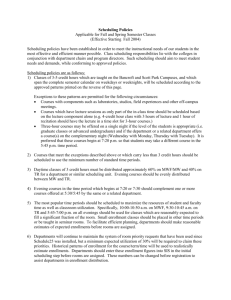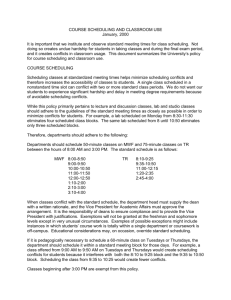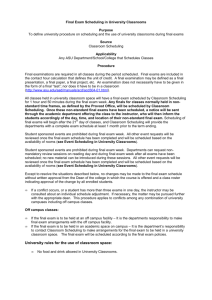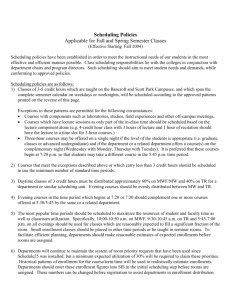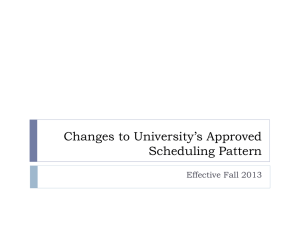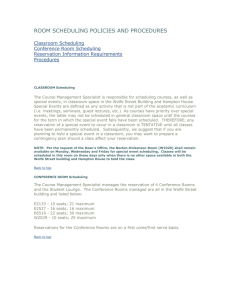COURSE SCHEDULING GUIDELINES
advertisement
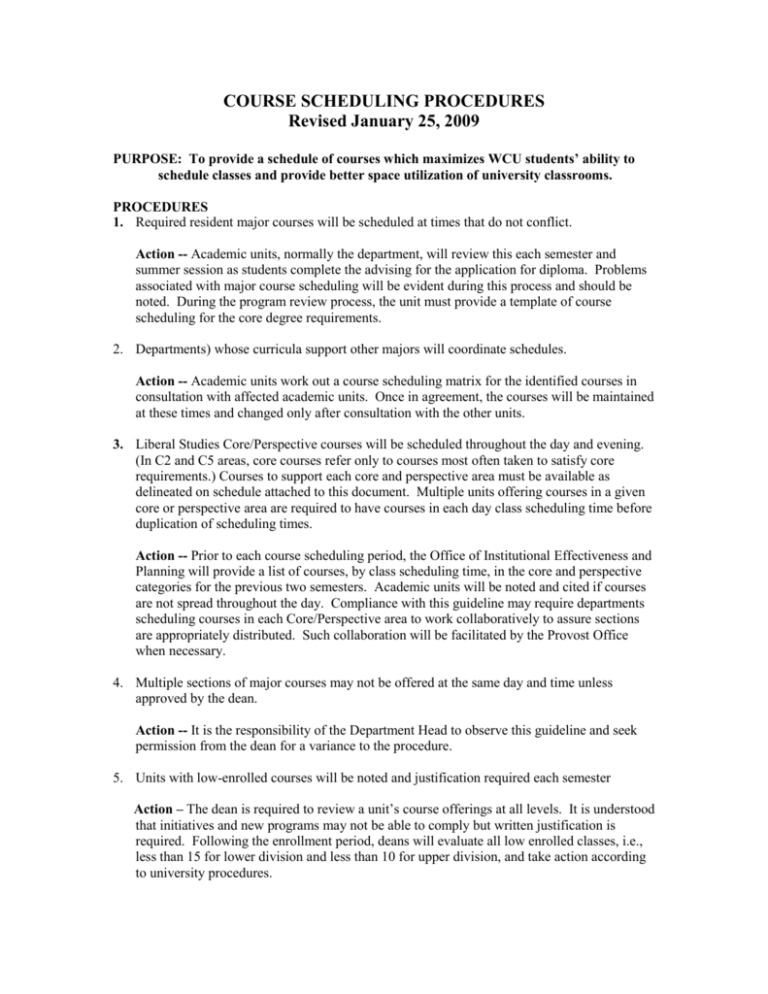
COURSE SCHEDULING PROCEDURES Revised January 25, 2009 PURPOSE: To provide a schedule of courses which maximizes WCU students’ ability to schedule classes and provide better space utilization of university classrooms. PROCEDURES 1. Required resident major courses will be scheduled at times that do not conflict. Action -- Academic units, normally the department, will review this each semester and summer session as students complete the advising for the application for diploma. Problems associated with major course scheduling will be evident during this process and should be noted. During the program review process, the unit must provide a template of course scheduling for the core degree requirements. 2. Departments) whose curricula support other majors will coordinate schedules. Action -- Academic units work out a course scheduling matrix for the identified courses in consultation with affected academic units. Once in agreement, the courses will be maintained at these times and changed only after consultation with the other units. 3. Liberal Studies Core/Perspective courses will be scheduled throughout the day and evening. (In C2 and C5 areas, core courses refer only to courses most often taken to satisfy core requirements.) Courses to support each core and perspective area must be available as delineated on schedule attached to this document. Multiple units offering courses in a given core or perspective area are required to have courses in each day class scheduling time before duplication of scheduling times. Action -- Prior to each course scheduling period, the Office of Institutional Effectiveness and Planning will provide a list of courses, by class scheduling time, in the core and perspective categories for the previous two semesters. Academic units will be noted and cited if courses are not spread throughout the day. Compliance with this guideline may require departments scheduling courses in each Core/Perspective area to work collaboratively to assure sections are appropriately distributed. Such collaboration will be facilitated by the Provost Office when necessary. 4. Multiple sections of major courses may not be offered at the same day and time unless approved by the dean. Action -- It is the responsibility of the Department Head to observe this guideline and seek permission from the dean for a variance to the procedure. 5. Units with low-enrolled courses will be noted and justification required each semester Action – The dean is required to review a unit’s course offerings at all levels. It is understood that initiatives and new programs may not be able to comply but written justification is required. Following the enrollment period, deans will evaluate all low enrolled classes, i.e., less than 15 for lower division and less than 10 for upper division, and take action according to university procedures. 6. A review of programs and academic unit’s ability to meet these procedures will be conducted annually through the Office of Institutional Effectiveness and Planning. The following matrix of class meeting times shall be used by the deans of the colleges/school to schedule resident classes in academic units. The matrix applies to the entire set of undergraduate and graduate classes offered by the school/college, not individual departments. Deans shall set expectations for departments and may allow some departments to vary from the matrix should deans deem it appropriate to do so to meet disciplinary requirements. On-line courses refer to courses delivered completely on-line, not hybrid classes, and should NOT be counted in the matrix. . Classes beginning at 5:00 p.m. or later are considered evening classes. MWF Classes: Between 55 and 70% of total classes. Percentages below refer to the number of MWF, MW, and WF classes offered. Class Period No Less Than No More Than 8:00 10% 50% 9:05 10:10 11:15 12:20 15% 25% 1:25 2:30 20% 3:35 4:40 Evening 15% T-TH Classes: Between 30 to 50% of total classes offered. Percentages below refer to the number of T-R classes offered. Class Period No Less No More Than Than 8:00 10% 9:30 40% 11:00 12:35 10% 2:05 15% 30% 3:35 Evening 15% Class Scheduling Parameters/Best Practice: Required major courses will be scheduled at times that do not conflict. Department heads whose curricula support each other’s majors will coordinate schedules to assure required courses do no conflict. Multiple sections of the same course will be scheduled throughout the day and evening. It is recognized that a cultural shift on the part of students and faculty concerning teaching assignments and students enrollment for 8:00 a.m. and evening classes must occur. Deans will schedule required courses or those of proven high interest during those times. Day classes are defined as those with start times between 8:00 a.m. and 3:35 p.m.

